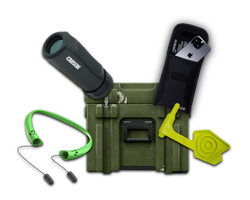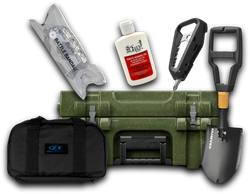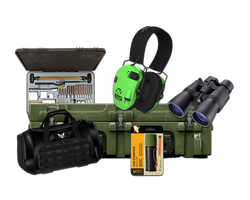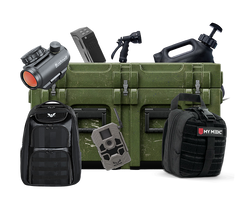What Targets Are Ideal for Rifle Shooting?
Table of Contents
- Introduction
- Understanding Target Types in Rifle Shooting
- Selecting the Right Target for Your Skill Level
- Tips for Effective Target Shooting
- Conclusion
- FAQ
Introduction
Imagine standing at a shooting range, the scent of gunpowder in the air, the weight of your rifle comfortably nestled against your shoulder. You've got your eye on the target, but as you focus your aim, you might wonder: what truly are the best targets for rifle shooting? This question is not merely academic; the type of target you choose can significantly affect your shooting experience and skill development.
In the realm of rifle shooting, selecting the right target is paramount for honing your marksmanship. Whether you’re a novice looking to improve your accuracy or a seasoned professional preparing for a competitive event, understanding the characteristics of various targets is essential. This article aims to delve into the different types of targets ideal for rifle shooting, discussing their unique attributes, benefits, and how they can enhance your shooting practice.
By the end of this post, you will have a comprehensive understanding of the types of targets available for rifle shooting, how to select the right target based on your skill level, and tips for effectively using each target type to elevate your shooting game. Let’s gear up and hit the ground running!
Understanding Target Types in Rifle Shooting
When it comes to rifle shooting, targets come in a variety of forms, each designed to serve specific training purposes. Understanding these variations will help you make informed choices that align with your shooting goals. Here are the primary types of targets you will encounter:
1. Paper Targets
Paper targets are among the most common and economical options available to shooters. They can range from simple bullseyes to complex designs like human silhouettes or animal shapes.
Benefits of Paper Targets:
- Immediate Feedback: Paper targets provide clear feedback on shot placement, allowing shooters to analyze their accuracy and make adjustments.
- Variety of Designs: From traditional bullseyes to reactive splatter targets, there's something for every skill level and training goal.
- Cost-Effective: Paper targets are typically inexpensive, making them ideal for extensive practice sessions.
Ideal Usage:
Paper targets are perfect for beginners who are just starting to develop their shooting skills. They are also beneficial for more experienced shooters when fine-tuning their accuracy. For a reliable option, consider using EasyShot Silhouette Paper Targets or BIRCHWOOD CASEY Bull's-Eye Reactive Targets, both of which offer durability and visibility.
2. Steel Targets
Steel targets are a favorite among many rifle enthusiasts for their durability and the auditory feedback they provide. These targets come in various shapes and sizes, including silhouettes, plates, and spinners.
Benefits of Steel Targets:
- Longevity: With proper care, steel targets can last for years, providing excellent value for your investment.
- Auditory Feedback: The satisfying "ping" when you hit a steel target adds an engaging element to your practice.
- Reactive Options: Many steel targets are reactive, swinging or falling when hit, which can add a dynamic aspect to shooting sessions.
Ideal Usage:
Steel targets are best suited for shooters who have mastered the basics and are ready to challenge their skills. They are particularly useful for practicing at longer distances. FULLBOW AR500 Steel Target Hangers or Birchwood Casey Steel Spinner Targets are great choices for those looking to incorporate steel into their training.
3. Clay Targets
Traditionally associated with shotgun shooting, clay targets can also be used with rifles, albeit from a distance. These disc-shaped targets fly through the air, making them a challenging option for shooters.
Benefits of Clay Targets:
- Challenging Dynamics: Shooting at moving targets enhances tracking and reflex skills, making it a great training tool.
- Instant Feedback: When hit, clay targets explode into pieces, providing immediate visual confirmation of a successful shot.
Ideal Usage:
Clay targets are ideal for intermediate to advanced shooters looking to improve their ability to shoot moving objects. They require a different skill set compared to stationary targets, making them an excellent way to diversify training. For reliable clay targets, consider the White Flyer Blackout Trap and Skeet Targets.
4. Polymer Targets
Polymer targets are a newer entry into the world of shooting targets, offering unique features that set them apart from traditional options. They are typically lighter than steel and can withstand multiple hits without significant damage.
Benefits of Polymer Targets:
- Self-Healing Properties: Many polymer targets can absorb impacts and return to their original shape, making them durable and cost-effective.
- Versatile Usage: They can be used with various calibers and are suitable for both indoor and outdoor shooting scenarios.
Ideal Usage:
Polymer targets are particularly useful for shooters who want a long-lasting target that can withstand repeated hits. They are suitable for all skill levels, making them a great addition to any shooting range. Caldwell Duramax Targets are an excellent option, featuring a variety of shapes and sizes for different training needs.
Selecting the Right Target for Your Skill Level
Choosing the right target depends not only on the type of shooting you plan to do but also on your experience level. Here are some guidelines to help you select the most appropriate target based on your shooting skills:
For Beginners
- Stick with Paper Targets: Start with paper targets to develop fundamental shooting skills such as proper stance, grip, and trigger control. The clear feedback provided by paper targets can help you understand your shooting patterns and areas for improvement.
- Gradually Introduce Steel Targets: Once you feel comfortable with basic shooting techniques, consider adding steel targets to your practice sessions for more dynamic training.
For Intermediate Shooters
- Incorporate a Mix: As you progress, try a combination of paper, steel, and clay targets. This will challenge your skills and help you adapt to different shooting scenarios.
- Focus on Reaction Time: Use steel or clay targets to improve your reaction time and tracking ability, essential skills for advanced shooting.
For Advanced Shooters
- Challenge Yourself with Moving Targets: Advanced shooters should prioritize clay and steel targets to enhance their shooting precision under dynamic conditions.
- Experiment with Polymer Targets: Incorporating polymer targets can add variety to your training while providing durable and effective practice options.
Tips for Effective Target Shooting
To ensure you get the most out of your target shooting sessions, consider the following tips:
Establish a Routine
Consistency is key in developing shooting skills. Establish a regular practice schedule that allows you to gradually build your skills and confidence.
Analyze Your Performance
After each shooting session, take the time to review your target hits. Look for patterns in your shots, and use that information to adjust your technique. This self-analysis will help you identify areas for improvement.
Use Quality Gear
Investing in high-quality rifles and accessories is essential for improving your shooting experience. Reliable firearms, scopes, and ammunition can significantly enhance your accuracy and overall enjoyment of the sport.
Safety First
Always prioritize safety when shooting. Familiarize yourself with the four basic rules of firearm safety:
- Treat every firearm as if it's loaded.
- Never point the muzzle at anything you are not willing to destroy.
- Keep your finger off the trigger until ready to shoot.
- Be aware of your target and what lies beyond it.
Conclusion
Selecting the right targets for rifle shooting is crucial for developing your skills, improving accuracy, and enhancing your overall shooting experience. From paper to steel, clay, and polymer, each target type offers unique benefits and challenges that cater to different skill levels. By understanding these attributes and incorporating them into your practice, you can tailor your training to meet your specific needs and aspirations.
Whether you're a beginner eager to improve or an experienced shooter looking to refine your technique, the right targets will contribute to your growth as a marksman. As you explore the world of rifle shooting, remember that practice and perseverance are key. Equip yourself with quality gear and engage with the Crate Club community to share experiences and insights.
Ready to elevate your shooting experience? Consider checking out Crate Club's subscription services for curated tactical gear and tools that can enhance your practice. Explore the Crate Club Subscription Services for tailored options that suit your needs, or visit the Crate Club Shop for high-quality shooting accessories and gear.
FAQ
What is the best type of target for a beginner shooter?
Paper targets are ideal for beginners as they provide immediate feedback on accuracy and allow shooters to develop their skills in a controlled environment.
Are steel targets safe for rifle shooting?
Yes, steel targets are safe for rifle shooting as long as appropriate distances and calibers are used. Always follow safety guidelines to ensure a safe shooting experience.
How often should I practice shooting?
Consistency is vital. Aim to practice at least once a week, gradually increasing the frequency as your skills improve.
Can I use clay targets with a rifle?
Yes, clay targets can be used with rifles, but they are typically shot from a distance of over 100 yards for the best results.
What should I do if I notice a pattern in my shooting?
Analyze your performance and adjust your technique accordingly. Focus on your stance, grip, and trigger control to improve accuracy.
Share this article



